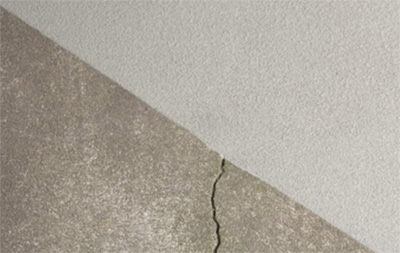Epoxy floor coatings are measured in ‘mils’ (thousandths of an inch). A medium build epoxy coating system will cure at 7-15 mils. A high build epoxy coating system will dry at 20-35 mils. If you need to ‘level’ just ¼”, that would be 250 mils, so you can see why using an epoxy to make floor repairs or ‘level’ a floor would be impractical and expensive. Broom finish floors and rough surface floors can have surface variations of up to 1/8” (125 mils) and normally cannot be leveled by epoxy only. The term ‘self-leveling’ means that the epoxy will smooth itself out in most cases, at the thickness it is applied at.

This demonstrates the thickness of epoxy floor covering compared to a quarter. In comparison, a typical paint coat is as thin as a piece of paper.
Leveling and patching holes, spalls, and corrosion
These kinds of floors are not easily repaired using an epoxy so use a commercially available cementitious type floor resurfacer. These products are available nationwide at home centers and building material centers and are often referred to as ‘skim coat’ products and come in 50lb cement type bags. A 50lb bag will level only 25 square feet (5’ x 5’) to a depth of 1/4:”, so if you need a lot of leveling, you may need quite a few bags to repair your floor. Use these types of products for salt corroded floors and worn floors where the aggregate (rock) is exposed or the floor has ‘acne’ and is pitted. Allow adequate time, according to manufacturer’s recommendations, for curing prior to applying the epoxy. These types of products are normally installed with a ‘gauge rake’ and then smoothed over with a floor smoother.
Alternate option: Use an Epoxy Mortar Liquid Resin. This product is a 2 part epoxy into which you mix locally-purchased playground sand. Use the Epoxy Mortar for filling smaller areas, holes, spalls, etc. The product comes in a 1 gallon (holds 50lbs sand) or 3 gallon sizes (holds 150lbs of sand). The Epoxy Mortar Resin can also be used to make ‘coves’ that are often required by health departments for where walls meet floors in kitchens and baths. You’ll need a ‘Cove Tool’ which is a curved trowel that ‘makes’ the cove.
Crack Filling: Remove any loose or flaking material from cracks. Use angle grinder or other tools if necessary.

Hairline cracks cannot be filled in with epoxy. Since epoxies are liquid coatings without aggregate, they will ‘fall into’ cracks and the cracks may still appear. Use a Crack Repair Epoxy Putty for small areas, and minor corroded areas. This product is a 2 part very thick putty-like product that you mix in equal parts on a piece of cardboard or wood, and then use a putty knife to apply to small cracks up to 3/8” wide. It mixes and works similar to auto body-type fillers. This is an excellent product that you can paint right over, and does not require drying or curing time.
Larger cracks use Epoxy Mortar. To fill expansion joints or saw cuts in concrete, fill the joints with sand up to about 3”8” below the surface (this acts as a foundation), and then fill with Epoxy Mortar. For expansion joints with flexible materials, remove material down to at least ½” below the surface and fill with a Flexible Joint Sealer. This will allow the floor to expand and contract as designed. For filling smaller joints that need to be flexible, use a Fast Setting Epoxy Joint Filler. This product is like a caulk but much stronger, industrial grade, and faster setting.
